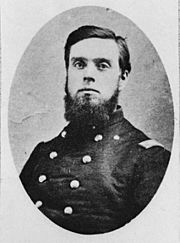Battle of Hoover's Gap facts for kids
Quick facts for kids Battle of Hoover's Gap |
|||||||
|---|---|---|---|---|---|---|---|
| Part of the American Civil War | |||||||
 Tullahoma Campaign |
|||||||
|
|||||||
| Belligerents | |||||||
| Commanders and leaders | |||||||
| William Rosecrans John T. Wilder |
Alexander P. Stewart William B. Bate |
||||||
| Units involved | |||||||
| XIV Corps | Stewart's Division | ||||||
| Casualties and losses | |||||||
| 61 | 146 | ||||||
The Battle of Hoover's Gap happened on June 24, 1863. It was a major fight during the Tullahoma Campaign of the American Civil War. In this battle, Union General William Rosecrans pushed Confederate General Braxton Bragg out of Central Tennessee.
General Rosecrans used a clever trick. He pretended to attack the western side of the Confederate lines. This made the eastern mountain passes less protected. Colonel John T. Wilder's mounted infantry then launched a surprise attack on Hoover's Gap. The Union's success came from Rosecrans's smart plans. It also came from the high spirits of Wilder's "Lightning Brigade". This special group of soldiers had new Spencer repeating rifles.
Contents
About the Battle of Hoover's Gap
Why the Battle Happened
After the Battle of Stones River, Union Major General William Rosecrans stayed near Murfreesboro, Tennessee. He was in charge of the Union Army of the Cumberland. To stop the Union from moving forward, Confederate General Braxton Bragg set up strong defenses. These defenses stretched along the Duck River. They went from Shelbyville to Wartrace.
On the Confederate right side, soldiers and cannons guarded important mountain passes. These included Liberty, Hoover's, and Bellbuckle Gaps. Rosecrans's leaders wanted him to attack. They worried that Bragg might send many soldiers to help break the Siege of Vicksburg.
Wilder's Lightning Brigade
One of Rosecrans's commanders was Colonel John T. Wilder. He was impressed by how Confederate General John Hunt Morgan raided behind Union lines. Wilder suggested a plan to make his own infantry brigade stronger. He wanted to get horses for his soldiers by raiding the countryside. Rosecrans agreed to his idea. By mid-April 1863, Wilder's brigade had horses and was ready.
Wilder also saw a new type of rifle demonstrated by Christopher Miner Spencer. It was a repeating rifle, meaning it could fire many shots quickly. Wilder decided his brigade needed these new weapons. His soldiers fully supported the idea. Each soldier promised to pay $35 for a Spencer repeating rifle. Wilder co-signed their notes and got a loan from banks in his hometown. Soon, his brigade had the new seven-shot rifles. They became known as the "Lightning Brigade" for their speed and firepower.
The Battle Begins
On June 23, 1863, Rosecrans made a fake attack on Shelbyville. At the same time, he gathered his main forces to attack Bragg's right side. Union troops then moved towards the mountain passes.
On June 24, Major General George Henry Thomas's soldiers attacked Hoover's Gap. Colonel Wilder's "Lightning Brigade" led the way. They moved very fast and reached the gap almost 9 miles ahead of Thomas's main army. Wilder's soldiers had their new Spencer repeating rifles. When they attacked, the Confederate 1st Kentucky Cavalry was quickly pushed back.
The Confederate cavalry fell back along the 7-mile length of Hoover's Gap. They ran into Brigadier General William B. Bate's brigade. This brigade was part of Major General Alexander P. Stewart's division.
Wilder had been told that Bate's brigade was defending the top of the gap. But Wilder found the summit empty. His soldiers could see Bate's camp in the valley below. Wilder had his troops get off their horses. He decided to hold the gap, even though his commander, Major General Joseph J. Reynolds, ordered him to retreat. Wilder dug in on the hills south of the gap. He was determined to hold this very advanced position.
Bate's brigade attacked all day, but they could not move the Union soldiers. When Wilder received orders again to fall back, he refused. He said he could hold his ground. Meanwhile, Brigadier General Bushrod Johnson's brigade arrived. Bate and Johnson planned one last attack on Wilder. This attack was also stopped. By 7:00 p.m., more Union units arrived at the gap. These were from Lovell Rousseau and John Milton Brannan's divisions.
A Brave Decision
When Wilder saw Generals Rosecrans and Thomas riding up, he expected to be scolded. He had ignored orders to pull back. Instead, Wilder rode to Rosecrans and explained his decision. He said he knew his soldiers could hold the gap. Rosecrans was very happy. He shook Wilder's hand and said, "Thank God for your decision. It would have cost us 2,000 lives to have taken this position if you had given it up."
Just then, Reynolds arrived. Before he could say anything, Rosecrans told him, "Wilder has done right. Promote him." The Union soldiers caused 146 casualties to the Confederates. The Union only had 61 casualties.
Just before noon on June 26, Stewart sent a message to Johnson and Bate. He told them he was pulling back and they should too. Even though it was raining, Rosecrans kept moving forward. This forced Bragg to leave his defensive line. Bragg fell back to Tullahoma.
After reaching Tullahoma, Rosecrans sent Wilder's Lightning Brigade ahead. Their mission was to attack the railroad behind Bragg's army. They arrived too late to destroy the Elk River railroad bridge. But the Union soldiers did destroy railroad tracks around Decherd.
What Happened Next
Bragg moved his forces out of Middle Tennessee. He withdrew to the city of Chattanooga, Tennessee. Rosecrans followed him. He captured Chattanooga on September 8, 1863. The fighting then continued in the Chickamauga Campaign.
Rosecrans was a bit disappointed. The victory at Hoover's Gap and the Tullahoma Campaign were important. But they were not as famous as two other Union victories that summer. These were the Siege of Vicksburg and the Battle of Gettysburg.
Images for kids



